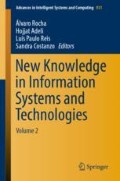Abstract
Future industrial systems, a revolution known as Industry 4.0, are envisioned to integrate people into cyber world as prosumers (service providers and consumers). In this context, human-driven processes appear as an essential reality and instruments to create feedback information loops between the social subsystem (people) and the cyber subsystem (technological components) are required. Although many different instruments have been proposed, nowadays pattern recognition techniques are the most promising ones. However, these solutions present some important pending problems. For example, they are dependent on the selected hardware to acquire information from users; or they present a limit on the precision of the recognition process. To address this situation, in this paper it is proposed a two-phase algorithm to integrate people in Industry 4.0 systems and human-driven processes. The algorithm defines complex actions as compositions of simple movements. Complex actions are recognized using Hidden Markov Models, and simple movements are recognized using Dynamic Time Warping. In that way, only movements are dependent on the employed hardware devices to capture information, and the precision of complex action recognition gets greatly increased. A real experimental validation is also carried out to evaluate and compare the performance of the proposed solution.
Access this chapter
Tax calculation will be finalised at checkout
Purchases are for personal use only
References
Bordel, B., Alcarria, R., Sánchez-de-Rivera, D., Robles, T.: Protecting industry 4.0 systems against the malicious effects of cyber-physical attacks. In: International Conference on Ubiquitous Computing and Ambient Intelligence, pp. 161–171. Springer, Cham (2017
Bordel, B., Alcarria, R., Robles, T., Martín, D.: Cyber–physical systems: extending pervasive sensing from control theory to the Internet of Things. Pervasive Mobile Comput. 40, 156–184 (2017)
Neff, W.: Work and Human Behavior. Routledge, London (2017)
Bordel, B., Alcarria, R., Martín, D., Robles, T., de Rivera, D.S.: Self-configuration in humanized cyber-physical systems. J. Ambient Intell. Hum. Comput. 8(4), 485–496 (2017)
Bordel, B., de Rivera, D.S., Sánchez-Picot, Á., Robles, T.: Physical processes control in industry 4.0-based systems: a focus on cyber-physical systems. In: Ubiquitous Computing and Ambient Intelligence, pp. 257–262. Springer, Cham (2016)
Pal, S.K., Wang, P.P.: Genetic Algorithms for Pattern Recognition. CRC Press, Boca Raton (2017)
Müller, M.: Dynamic time warping. In: Information Retrieval for Music and Motion, pp. 69–84 (2007)
Eddy, S.R.: Hidden Markov models. Current Opinion Struct. Biol. 6(3), 361–365 (1996)
Kim, E., Helal, S., Cook, D.: Human activity recognition and pattern discovery. IEEE Pervasive Comput./IEEE Comput. Soc. [and] IEEE Commun. Soc. 9(1), 48 (2010)
Li, Z., Wei, Z., Yue, Y., Wang, H., Jia, W., Burke, L.E., Sun, M.: An adaptive hidden markov model for activity recognition based on a wearable multi-sensor device. J. Med. Syst. 39(5), 57 (2015)
Ordonez, F.J., Englebienne, G., De Toledo, P., Van Kasteren, T., Sanchis, A., Krose, B.: In-home activity recognition: Bayesian inference for hidden Markov models. IEEE Pervasive Comput. 13(3), 67–75 (2014)
Zhan, K., Faux, S., Ramos, F.: Multi-scale conditional random fields for first-person activity recognition on elders and disabled patients. Pervasive Mob. Comput. 16, 251–267 (2015)
Liu, A.A., Nie, W.Z., Su, Y.T., Ma, L., Hao, T., Yang, Z.X.: Coupled hidden conditional random fields for RGB-D human action recognition. Signal Process. 112, 74–82 (2015)
Liu, J., Huang, M., Zhu, X.: Recognizing biomedical named entities using skip-chain conditional random fields. In: Proceedings of the 2010 Workshop on Biomedical Natural Language Processing, pp. 10–18. Association for Computational Linguistics (2010)
Gu, T., Wu, Z., Tao, X., Pung, H.K., Lu, J.: epSICAR: an emerging patterns based approach to sequential, interleaved and concurrent activity recognition. In: IEEE International Conference on Pervasive Computing and Communications, PerCom 2009, pp. 1–9. IEEE (2009)
Hu, B.G.: What are the differences between Bayesian classifiers and mutual-information classifiers? IEEE Trans. Neural Netw. Learn. Syst. 25(2), 249–264 (2014)
Wang, X., Liu, X., Pedrycz, W., Zhang, L.: Fuzzy rule based decision trees. Pattern Recognit. 48(1), 50–59 (2015)
Davis, M.H.: Markov Models & Optimization. Routledge, New York (2018)
Bordel Sánchez, B., Alcarria, R., Martín, D., Robles, T.: TF4SM: a framework for developing traceability solutions in small manufacturing companies. Sensors 15(11), 29478–29510 (2015)
Acknowledgments
The research leading to these results has received funding from the Ministry of Economy and Competitiveness through SEMOLA (TEC2015-68284-R) project and the Ministry of Science, Innovation and Universities through VACADENA (RTC-2017-6031-2) project.
Author information
Authors and Affiliations
Corresponding author
Editor information
Editors and Affiliations
Rights and permissions
Copyright information
© 2019 Springer Nature Switzerland AG
About this paper
Cite this paper
Bordel, B., Alcarria, R., Sánchez-de-Rivera, D. (2019). A Two-Phase Algorithm for Recognizing Human Activities in the Context of Industry 4.0 and Human-Driven Processes. In: Rocha, Á., Adeli, H., Reis, L., Costanzo, S. (eds) New Knowledge in Information Systems and Technologies. WorldCIST'19 2019. Advances in Intelligent Systems and Computing, vol 931. Springer, Cham. https://doi.org/10.1007/978-3-030-16184-2_18
Download citation
DOI: https://doi.org/10.1007/978-3-030-16184-2_18
Published:
Publisher Name: Springer, Cham
Print ISBN: 978-3-030-16183-5
Online ISBN: 978-3-030-16184-2
eBook Packages: Intelligent Technologies and RoboticsIntelligent Technologies and Robotics (R0)

